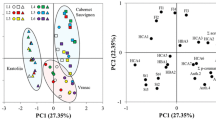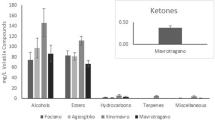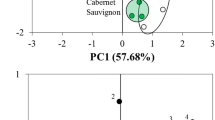Abstract
Grapevine cv. Riesling is a traditional variety of cool climate viticulture regions to which the Czech Republic belongs too. In total 35 wine samples from 9 different terroirs of wine-growing regions in the Czech Republic were evaluated for the content of 20 phenolic compounds comprising hydroxybenzoic acids, hydroxycinnamates, stilbenes, and flavan-3-ols. Phenolic compounds were evaluated by an HPLC method. Methods of multivariate statistical analysis were used to discriminate wine samples on the basis of their geographical origin. Canonical variate analysis proved that it is possible to differentiate wines according to their geographical origin by following authenticity markers: gallic acid, caffeic acid, caftartic acid, p-coutaric acid, ferulic acid ethylester, p-coumaric acid ethylester, (+)-catechin, and (−)-epicatechin. On the basis of statistical analyses, 100% wine samples were correctly classified. The results indicate that, for the case of white wines, mainly hydroxycinnamates and flavan-3-ols can be used for differentiation of their geographical origin.
Similar content being viewed by others
References
Seguin G. ’Terroirs’ and pedology of wine growing. Experientia 42: 861–873 (1986)
Van Leeuwen C, Roby JP, Pernet D, Bois B. Methodology of soilbased zoning for viticultural terroir. B. OIV 83: 13–29 (2010)
McGhie TK, Rowan DD. Metabolomics for measuring phytochemicals, and assessing human and animal responses to phytochemicals, in food science. Mol. Nutr. Food Res. 56: 147–158 (2012)
Galgano F, Caruso M, Perretti G, Favati F. Authentication of Italian red wines on the basis of the polyphenols and biogenic amines. Eur. Food Res.Technol. 232: 889–897 (2011)
Green JA, Parr WV, Breitmeyer J, Valentin D, Sherlock R. Sensory and chemical characterisation of Sauvignon blanc wine: Influence of source of origin. Food Res. Int. 44: 2788–2797 (2011)
Pérez-Trujillo JP, Conde JE, Pérez Pont ML, Camara J, Marques JC. Content in metallic ions of wines from the Madeira and Azores archipelagos. Food Chem. 124: 533–537 (2011)
Adami L, Dutra SV, Marcon AR, Carnelli GJ, Roani CA, Vanderlinde R. Geographic origin of southern Brazilian wines by carbon and oxygen isotope analysis. Rapid Commun. Mass Sp. 24: 2943–2948 (2010)
Dutra SV, Adami L, Marcon AR, Carnieli GJ, Roani CA, Spinelli FR, Leonardelli S, Ducatto C, Moreira MZ, Vanderlinde R. Determination of the geographical origin of Brazilian wines by isotope and mineral analysis. Anal. Bioanal. Chem. 401: 1571–1576 (2011)
Andreu-Navarro A, Russo P, Aguilar-Caballos MP, Fernández-Romero JM, Gómez-Hens A. Usefulness of terbium-sensitized luminescence detection for chemometric classification of wines by their content in phenolic compounds. Food Chem. 124: 1753–1759 (2011)
Ali K, Maltese F, Hae Choi Y, Verpoorte R. Metabolic constituents of grapevine and grape-derived products. Phytochem. Rev. 9: 357–378 (2010)
Rentzsch M, Wilkens A, Winterhalter P. Non-flavonoid phenolic compounds. pp. 509–527. In: Wine Chemistry and Biochemistry. Moreno-Arribas MV, Polo MC (eds). Springer Science+Bussiness Media, New York, NY, USA (2009)
Cheynier V, Schneider R, Salmon JM, Fulcrand H. Chemistry of wine. pp. 1119–1172. In: Comprehensive Natural Products II. Mander L, Liu HW (eds). Elsevier, Oxford, UK (2010)
De Luca V. Wines. pp. 241–255. In: Comprehensive Natural Products II. Mander L, Liu HW (eds). Elsevier, Oxford, UK (2010)
Waterhouse AL. Wine phenolics. Ann. NY Acad. Sci. 957: 21–36 (2002)
Pozo-Bayon MA, Hernandez MT, Martin-Alvarez PJ, Polo MC. Study of low molecular weight phenolic compounds during the aging of sparkling wines manufactured with red and white grape varieties. J. Agr. Food Chem. 51: 2089–2095 (2003)
Pour Nikfardjam MS, Köhler HJ, Schmitt A, Patz CD, Dietrich H. Polyphenolic composition of German white wines and its use for the identification of cultivar. Mit. Kloster. 57: 146–152 (2007)
Ballus CA, Dillenburg Meinhardt A, Grado de Oliveira R, Teixerira Godoy H. Optimization of capillary zone electrophoresis separation and on-line preconcentration of 16 phenolic compounds from wines produced in South Africa. Food Res. Int. 45: 136–144 (2012)
Dietrich H, Patz CD, Pour-Nikfardjam M, Hoffmann D, Greiner D, Bauer H. Chemical characterization of ‘Riesling’ wines of the years 1892 to 1921 from the Rheingau region. Mit. Kloster. 54: 222–233 (2000)
Kennedy JA, Saucier C, Glories Y. Grape and wine phenolics: History and perspective. Am. J. Enol. Viticult. 57: 239–248 (2006)
Ricardo-Da-Silva JM, Cheynier V, Samson A, Bourxeix M. Effect of pomace contact, carbonic maceration, and hyperoxidation on the procyanidin composition of Grenache blanc wines. Am. J. Enol. Viticult. 44: 168–172 (1993)
Nagel CW, Baranowski JD, Wulf LW, Powers JR. The hydroxycinnamic acid tartaric acid ester content of must and grape varieties grown in the Pacific northwest. Am. J. Enol. Viticult. 30: 198–201 (1979)
Ritter G, Götz H, Dietrich H. Investigation of phenolic substances in ‘Riesling’ wines from the Rheingau region. Vitic. Enol. Sci. 49: 71–77 (1994)
Makhotkina O, Klimartin PA. The use of cyclic voltammetry for wine analysis: Determination of polyphenols and free sulfur dioxide. Anal. Chim. Acta 668: 155–165 (2010)
Guebaila HA, Chira K, Richard T, Mabrouk T, Furiga A, Vitrac X, Monti JP, Delaunay JC, Merillon JM. Hopeaphenol: The first resveratrol tetramer in wines from north Africa. J. Agr. Food Chem. 54: 9559–9564 (2006)
Melzoch K, Hanzlíková I, Filip V, Buckiová D, Šmidrkal J. Resveratrol in Part sof vine and wine originating from Bohemian and Moravan vineyard regions. Agr. Consp. Sci. 66: 53–57 (2001)
Pour Nikfardjam MP, Rechner A, Patz CD, Dietrich H. Trans-resveratrol content of German wines. Vitic. Enol. Sci. 54: 17–20 (1999)
Faitová K, Hejtmánková A, Lachman J, Pivec V, Dudjak J. The contents of total polyphenolic compounds and trans-resveratrol in white ‘Riesling’ originated in the Czech Republic. Czech J. Food Sci. 22: 215–221 (2004)
Adams DO. Phenolics and ripening in grape berries. Am. J. Enol. Viticult. 57: 249–256 (2006)
Iriti M, Faoro F. Bioactive chemicals and health benefits of grapevine products. pp. 581–620. In: Bioactive Foods in Promoting Health. Watson RR, Preedy VR (eds). Academic Press, San Diego, CA, USA (2010)
Pena-Neira A, Hernández T, Garcia-Vallejo C, Estrella I, Suarez JA. A survey of phenolic compounds in Spanish wines of different geographical origin. Eur. Food Res. Technol. 210: 445–448 (2000)
Rastija V, Sreènik G, Medić-Šarić M. Polyphenolic composition of Croatian wines with different geographical origins. Food Chem. 115: 54–60 (2009)
Author information
Authors and Affiliations
Corresponding author
Rights and permissions
About this article
Cite this article
Kumšta, M., Pavloušek, P. & Kupsa, J. Phenolic profile in Czech white wines from different terroirs. Food Sci Biotechnol 21, 1593–1601 (2012). https://doi.org/10.1007/s10068-012-0212-0
Received:
Revised:
Accepted:
Published:
Issue Date:
DOI: https://doi.org/10.1007/s10068-012-0212-0




